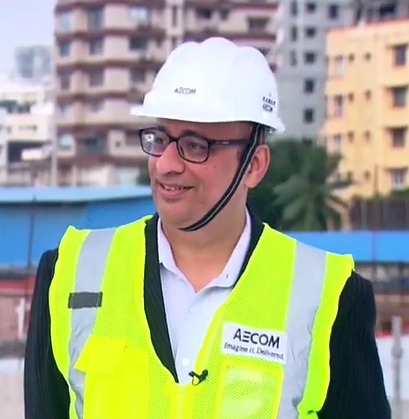Mumbai coastal road: 5 men who burnt midnight oil to see the project through
For Seoul-based Namkak Cho, who arrived in India for the first time in 2021 after being roped in as a tunnel expert, work began on day one, even as initial days were spent adjusting to the Indian accent. With his eyes set on the ultimate goal of building India’s largest tunnel ever, to him, the communication gap was “not a big deal”.
 The south-bound arm of the Mumbai Coastal Road Project will become operational from 8 am on Tuesday. (Express Photo by Sankhadeep Banerjee)
The south-bound arm of the Mumbai Coastal Road Project will become operational from 8 am on Tuesday. (Express Photo by Sankhadeep Banerjee)A part of the Mumbai Coastal Road Project (MCRP) is set to be inaugurated today. The Indian Express speaks to the five experts who played a key role in building the engineering marvel that will fundamentally change how Mumbaikars travel.
Namkak Cho, TBM Manager Coastal Road
For Seoul-based Namkak Cho, who arrived in India for the first time in 2021 after being roped in as a tunnel expert, work began on day one, even as initial days were spent adjusting to the Indian accent. With his eyes set on the ultimate goal of building India’s largest tunnel ever, to him, the communication gap was “not a big deal”.
“Initially, it took me some time to adjust to the Indian accent but it was not a big deal. For the most part, I didn’t face any language barrier as all engineers can speak in English. Although sometimes, when we met for client meetings, they would speak in Hindi and I would constantly ask BMC engineers as to what they were saying,” said Namkak Cho.
 Namkak Cho, TBM Manager Coastal Road (Express Photo by Amit Chakravarty)
Namkak Cho, TBM Manager Coastal Road (Express Photo by Amit Chakravarty)
As a tunnel expert, Cho’s work involved supervision of tunnel-related work, checking designs and carrying out observations. “When I first joined, the TBM assembly as well as the launching shaft was almost completed. They had also started to excavate the RHS tunnel. I was there from when the TBM was launched into the RHS tunnel to the final end,” he said.
To keep the TBM machine working — which operated 24 hours a day — Cho worked at least 12 hours a day. “The thumb of the rule for a TBM is that it shall not stop until the breakthrough, unless of course there is a breakdown,” he said.
Speaking of breakdown, Cho recalled that the biggest challenge of the project for him arose when the TBM machine shut down, owing to the breakdown of crusher, which stalled the project by two months.
Initially, Cho did not meet his family back home in Korea, for over a year. “Owing to Covid and other restrictions, I did not meet my family for a year. But now, I travel home to Korea once every six months,” he said.
Three years on, while Cho is yet to learn Hindi — ‘Namaste’ being his only acquired vocabulary — he is now well adjusted to Mumbai and is excited for the city to experience the many firsts the project promises. Cho said, “The finished diameter of the tunnel is 11 m, making it the largest tunnel in India cut using a TBM machine. Furthermore, for the first time, the Saccardo ventilation and fire board technology have been used in India.”
Mantayya Swami
Deputy Chief Engineer
Chief Engineer – I/c
As the first phase of the coastal road opens, Mantayya Swami cannot help but hark back to the genesis of the project, when they worked out of a small office at Ghatkopar and the many challenges the project encountered.
The engineer, as the project progressed, rose to the ranks of deputy chief engineer in the coastal roads department. Between 2022 and 2024, he took charge as the chief engineer and was entrusted with the task of taking key decisions pertaining to MCRP.

“Earlier, we were under the chief engineer (roads) and our office was located in Ghatkopar. We worked with a small team in a small office there. Later we worked out of an office near Sion, before finally shifting to the Engineer’s Hub in Worli, and under a separate department… We faced several legal battles… At times, we would go to court thrice every week. Six petitions were filed against the project. After the high court stay, we challenged the matter in Supreme Court, which stalled the work by several months,” he said.
According to Swami, had it not been for the litigations, the project would have been completed a year earlier. Besides proceedings, the Covid lockdown also hit the project. “The TBM arrived during the lockdown, and we transported it in 76 trailers. However, owing to Covid restrictions, the experts required couldn’t travel. Even supplies were affected, which further slowed down the process.” But the lockdown was not without its benefits. He added, “It gave us the advantage of undertaking faster reclamation.”
Vijay Zore
Sub-Engineer – MCRP
part of project from 2014
One of the earliest persons to join the coastal road project in 2014 after a stint at MMRDA, Vijay Zore wasn’t convinced the project would turn into reality. Ten years on, and countless hours of work later, Zore says, “If you really put your mind to something, dreams do come true.”
Recalling initial days, Zore told The Indian Express, “At initial levels in the inception report, the project was estimated to cost Rs 8,900 crore. The government had never before undertaken such a large project. The plan proposed in the inception report was similar to projects attempted in Singapore, Netherlands and other western countries. At that time, we didn’t have the expertise to execute such a project in India. The whole idea initially seemed impossible.”
 Vijay Zore Senior Engg Coastal Road ( Express Photo by Amit Chakravarty)
Vijay Zore Senior Engg Coastal Road ( Express Photo by Amit Chakravarty)
From DPR bids to studying reports on reclamation, bridge and geotechnical designs, appointment for peer review consultants on tunnels to inviting suggestions and objections from Mumbaikars and more, the project took off in fast gear.
For Zore, however, some of the biggest roadblocks arrived in the form of litigation. “When HC stayed the order of CRZ clearance in July 2019, it put the project on a complete halt for nine months. That period was very critical for us.”
In a bid to prepare the legal framework for proceedings in nine months, Zore added, “Sometimes, we would work with lawyers until 4 am, and would be back in court by 9 am. On other occasions, we would even have early morning meetings with advocates. A huge stockpile of documentation was created during this period, and this proved to be one of the most challenging phases.”
Between initial doubts and hours of toil thereafter, when the final work order was issued, Zore knew the coastal road project would finally become a reality.
With MCRP launching on Monday, Zore smiles, “It is a dream come true for me.”
Vipul Surana
Team Leader at AECOM
General Consultant
With MCRP being a one-of-its-kind project in the country, AECOM— which has undertaken works on infrastructural projects in Hong Kong, Singapore, MTHL and others— was roped in as the general consultant on the MCRP, when it was conceptualised.
As the general consultant, Vipul Surana, team leader from AECOM, explained their role, “Since a project of such a scale was being conceived from scratch, we helped the client from the group up, even before other consultants were appointed. We wrote specifications for the project, understood challenges of the client, helped in preparing the DCR on the basis of which tenders were then floated. Besides everything, we also helped our clients during court proceedings.”

Despite having executed projects worldwide, Surana said the MCRP was a very exciting project. “Very rarely do we undertake a project that has everything — tunnels under hills and the sea, reclamation, bridges, etc.”
For him, the biggest challenge arrived during Covid, when labourers began returning to their hometowns due to restrictions. “From full strength, our labourers were reduced to half. The government, however, encouraged them by setting up camps and convinced them to stay back,” he said.
As the city inches towards the opening of the MCRP, Surana’s mood is on an upswing. “Of course, the project is going to cut short travel time. But we are also thrilled to be adding a lot of new green space to the city. Besides greening of the median, we are creating new promenades, carrying out landscaping and greening works. In the new open spaces that we have now created, Mumbai will have new places to visit.”
Sandeep Singh
Project Director L&T
for Package I and IV
Thanks to the many novelties involved, Sandeep Singh, project director of L&T, and his team were thrilled to be working on the coastal road project. After an 18-year stint in Delhi, wherein he worked on illustrious projects including Delhi Metro, Singh arrived in Mumbai in 2018. However, the path was laid with an array of challenges.
Recalling them, Singh told Express, “Soon after the project began in October 2018, a series of litigations and PILs would cause a constant start work-stop work scenario.” However, the biggest challenge came during the pandemic. “One problem followed another. Initially it was litigation, then Covid. When the Chinese TBM machine was brought in, Covid had begun. Since the Chinese, who are the Original Equipment Manufacturer (OEMs) could not travel owing to the lockdown, we in India were now grappling with operating the machine without expertise or guidance of its original makers.”
 Sandeep Singh, Project Director L&T (Express Photo by Amit Chakravarty)
Sandeep Singh, Project Director L&T (Express Photo by Amit Chakravarty)
But that proved no deterrent for Singh and his team, who went back to the drawing board and started connecting with the Chinese on Skype. “With minimal support of original manufacturers, we created the entire TBM set-up in our backyard. Later, we lowered the 1,400-tonne TBM machine using breakthrough technology, which has not been used more than twice or thrice in the world.”
Not only did the Indian team decode the mechanism on their own but also made corrections to the original drawings made by the Chinese. With the project nearing completion, Singh acknowledges some silver lining in the dark Covid cloud afterall. He said, “Due to the lockdown, the streets were empty and we could do the reclamation works much faster. Secondly, we were more focused on the work as we were confined to our homes. From Switzerland to Faridabad, we would all connect over video calls.”
He added, “We did not think of the pandemic as a holiday. We had a bigger purpose. We came from different parts of India and all of us strived to do something. There was nobody asking us why we weren’t working. We ourselves were driven and that kept pushing us.”







